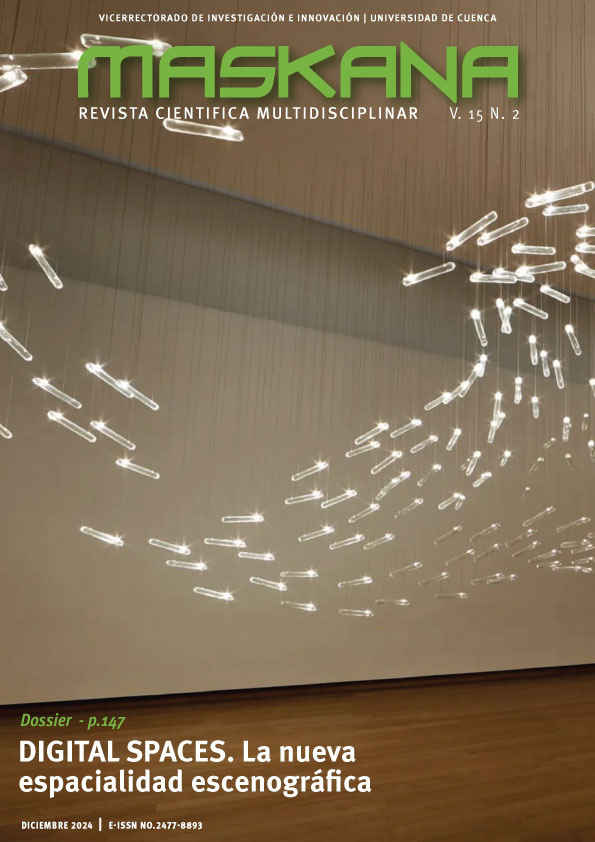Impacto del consumo de sustancias y la violencia de género en la salud mental y la toma de decisiones bajo riesgo y ambigüedad: perspectivas de la Tarea de Iowa en población encarcelada
DOI:
https://doi.org/10.18537/mskn.15.02.07Palabras clave:
Toma de decisiones, abuso de sustancias, violencia doméstica, rehabilitación, psicopatologíaResumen
La investigación sobre la toma de decisiones, la salud, el temperamento y la psicopatología de los reclusos destaca la importancia de la salud mental y la rehabilitación en las prisiones. El estudio se centra en la alta prevalencia de trastornos mentales, examinando la personalidad y la toma de decisiones, particularmente en aquellos con antecedentes de abuso de sustancias y violencia doméstica. Se enfatiza la necesidad de intervenciones específicas en los entornos penitenciarios. Este estudio evaluó la toma de decisiones bajo ambigüedad y riesgo en 51 reclusos varones de la Prisión Provincial de Granada, incluyendo a aquellos con antecedentes de abuso de drogas, violencia doméstica o ninguno de estos. La toma de decisiones se evaluó mediante la tarea de Iowa Gambling, mientras que la salud mental y física se midió con el SF-36, la personalidad con el TCI-R, y la psicopatología con el MCMI-IV. No se encontraron diferencias significativas en la toma de decisiones entre los grupos de reclusos. Sin embargo, aquellos con antecedentes de abuso de sustancias y violencia doméstica mostraron una toma de decisiones consistentemente deficiente. El grupo de violencia doméstica obtuvo puntuaciones significativamente más bajas en el Bloque 5 en comparación con aquellos sin tales antecedentes. Este grupo también presentó mayores limitaciones físicas, dependencia emocional y comportamientos compulsivos. El grupo de abuso de sustancias mostró mayor búsqueda de novedad, comportamiento antisocial, agresividad, síntomas de trastorno de personalidad límite, abuso de alcohol y depresión. El estudio subraya el impacto del abuso de sustancias y la violencia doméstica en la toma de decisiones, los rasgos psicológicos y la salud física entre los hombres encarcelados. Destaca la necesidad de intervenciones personalizadas para abordar problemas cognitivos y conductuales específicos, lo que podría mejorar los resultados de la rehabilitación y reducir la reincidencia.
Descargas
Métricas
Citas
Alemayehu, F., Ambaw, F., & Gutema, H. (2019). Depression and associated factors among prisoners in Bahir Dar Prison, Ethiopia. BMC psychiatry, 19(1), 88. https://doi.org/10.1186/s12888-019-2071-1
Allen, S., Flaherty, C., Gretchen, E. (2010). Throwaway Moms: Maternal incarceration of the criminalization of female poverty. Journal of Women and Social Work, 25(2), 160–172.
Allnutt, S., Wedgwood, L., Wilhelm, K., & Butler, T. (2008). Temperament, substance use and psychopathology in a prisoner population: implications for treatment. The Australian and New Zealand journal of psychiatry, 42(11), 969–975. https://doi.org/10.1080/00048670802415350
Alonso, J., Prieto, L., y Antó, J. M. (1995). La versión española del SF-36 Health Survey (Cuestionario de Salud SF-36): un instrumento para la medida de los resultados clínicos. Medicina Clínica, 104(20), 771-776.
Andrews, D.A., Bonta, J. and Wormith, S.J. (2006), The recent past and near future of risk and need assessment, Crime & Delinquency, 52(1), 7-27.
Applegate, B. K., Pasquire, N., & Ouellette, H. M. (2024). The Prevalence of Physical and Mental Health Multimorbidity Among People Held in U.S. Jails. Journal of correctional health care: the official journal of the National Commission on Correctional Health Care, 30(1), 7–13. https://doi.org/10.1089/jchc.23.05.0040
Balcioglu, Y. H., Kirlioglu Balcioglu, S. S., Oncu, F., & Turkcan, A. (2021). Psychopathy, temperament, and character dimensions of personality as risk determinants of criminal recidivism in schizophrenia patients. Journal of forensic sciences, 66(6), 2340–2353. https://doi.org/10.1111/1556-4029.14834
Beaudette, J. N., & Stewart, L. A. (2016). National Prevalence of Mental Disorders among Incoming Canadian Male Offenders. Canadian journal of psychiatry. Revue canadienne de psychiatrie, 61(10), 624–632. https://doi.org/10.1177/0706743716639929
Bechara, A., Damasio, A. R., Damasio, H., & Anderson, S. W. (1994). Insensitivity to future consequences following damage to human prefrontal cortex. Cognition, 50(1-3), 7–15. https://doi.org/10.1016/0010-0277(94)90018-3
Bechara, A. (2007). Iowa Gambling Task Professional Manual. Psychological Assessment Resources, Inc.
Block, R. A., Hancock, P. A., & Zakay, D. (2010). How cognitive load affects duration judgments: A meta-analytic review. Acta psychologica, 134(3), 330–343. https://doi.org/10.1016/j.actpsy.2010.03.006
Brand, M., Fujiwara, E., Borsutzky, S., Kalbe, E., Kessler, J., & Markowitsch, H. J. (2005). Decision-making deficits of korsakoff patients in a new gambling task with explicit rules: associations with executive functions. Neuropsychology, 19(3), 267–277. https://doi.org/10.1037/0894-4105.19.3.267
Brand, M., Recknor, E. C., Grabenhorst, F., & Bechara, A. (2007). Decisions under ambiguity and decisions under risk: correlations with executive functions and comparisons of two different gambling tasks with implicit and explicit rules. Journal of clinical and experimental neuropsychology, 29(1), 86–99. https://doi.org/10.1080/13803390500507196
Brinded, P. M., Simpson, A. I., Laidlaw, T. M., Fairley, N., & Malcolm, F. (2001). Prevalence of psychiatric disorders in New Zealand prisons: a national study. The Australian and New Zealand journal of psychiatry, 35(2), 166–173. https://doi.org/10.1046/j.1440-1614.2001.00885.x
Busemeyer, J. R., & Stout, J. C. (2002). A contribution of cognitive decision models to clinical assessment: Decomposing performance on the Bechara gambling task. Psychological Assessment, 14(3), 253–262. https://doi.org/10.1037/1040-3590.14.3.253
Butler, A., Nicholls, T., Samji, H., Fabian, S., & Lavergne, M. R. (2022). Prevalence of Mental Health Needs, Substance Use, and Co-occurring Disorders Among People Admitted to Prison. Psychiatric services (Washington, D.C.), 73(7), 737–744. https://doi.org/10.1176/appi.ps.202000927
Capezza, N. M., D'Intino, L. A., Flynn, M. A., & Arriaga, X. B. (2021). Perceptions of Psychological Abuse: The Role of Perpetrator Gender, Victim's Response, and Sexism. Journal of interpersonal violence, 36(3-4), 1414–1436. https://doi.org/10.1177/0886260517741215
Churchwell, J. C., Carey, P. D., Ferrett, H. L., Stein, D. J., & Yurgelun-Todd, D. A. (2012). Abnormal striatal circuitry and intensified novelty seeking among adolescents who abuse methamphetamine and cannabis. Developmental neuroscience, 34(4), 310–317. https://doi.org/10.1159/000337724
Collison, K. L., & Lynam, D. R. (2021). Personality disorders as predictors of intimate partner violence: A meta-analysis. Clinical psychology review, 88, 102047. https://doi.org/10.1016/j.cpr.2021.102047
Cooper, J. A., Onyeka, I., O'Reilly, D., Kirk, R., & Donnelly, M. (2022). Record linkage studies of drug-related deaths among former adult prisoners who have been released to the community: a scoping review protocol. BMJ open, 12(3), e056598. https://doi.org/10.1136/bmjopen-2021-056598
Craig A. D. (2003). Interoception: the sense of the physiological condition of the body. Current opinion in neurobiology, 13(4), 500–505. https://doi.org/10.1016/s0959-4388(03)00090-4
Crone, E. A., & van der Molen, M. W. (2004). Developmental changes in real-life decision making: performance on a gambling task previously shown to depend on the ventromedial prefrontal cortex. Developmental neuropsychology, 25(3), 251–279. https://doi.org/10.1207/s15326942dn2503_2
De Brito, S. A., Viding, E., Kumari, V., Blackwood, N., & Hodgins, S. (2013). Cool and hot executive function impairments in violent offenders with antisocial personality disorder with and without psychopathy. PloS One, 8(6), e65566. https://doi.org/10.1371/journal.pone.0065566
Derlic D. (2020). A Systematic Review of Literature: Alternative Offender Rehabilitation-Prison Yoga, Mindfulness, and Meditation. Journal of correctional health care: the official journal of the National Commission on Correctional Health Care, 26(4), 361–375. https://doi.org/10.1177/1078345820953837
Diamond, P. M., Wang, E. W., Holzer, C. E., 3rd, Thomas, C., & des Anges Cruser (2001). The prevalence of mental illness in prison. Administration and policy in mental health, 29(1), 21–40. https://doi.org/10.1023/a:1013164814732
Dixon, M. R., Marley, J., & Jacobs, E. A. (2003). Delay discounting by pathological gamblers. Journal of applied behavior analysis, 36(4), 449–458. https://doi.org/10.1901/jaba.2003.36-449
Dolan, P., Hallsworth, M., Halpern, D., King, D., Metcalfe, R., & Vlaev, I. (2012). Influencing behaviour: The mindspace way. Journal of Economic Psychology, 33(1), 264–277. https://doi.org/10.1016/j.joep.2011.10.009
De Wit H. (2009). Impulsivity as a determinant and consequence of drug use: a review of underlying processes. Addiction biology, 14(1), 22–31. https://doi.org/10.1111/j.1369-1600.2008.00129.x
Dumont, D. M., Brockmann, B., Dickman, S., Alexander, N., & Rich, J. D. (2012). Public health and the epidemic of incarceration. Annual review of public health, 33, 325–339. https://doi.org/10.1146/annurev-publhealth-031811-124614
Ehrensaft, M. K., Cohen, P., & Johnson, J. G. (2006). Development of personality disorder symptoms and the risk for partner violence. Journal of abnormal psychology, 115(3), 474–483. https://doi.org/10.1037/0021-843X.115.3.474
Fakhrzadegan, S., Gholami-Doon, H., Shamloo, B., & Shokouhi-Moqhaddam, S. (2017). The Relationship between Personality Disorders and the Type of Crime Committed and Substance Used among Prisoners. Addiction & health, 9(2), 64–71
Fazel, S., Bains, P., & Doll, H. (2006). Substance abuse and dependence in prisoners: a systematic review. Addiction (Abingdon, England), 101(2), 181–191. https://doi.org/10.1111/j.1360-0443.2006.01316.x
Fazel, S., & Danesh, J. (2002). Serious mental disorder in 23000 prisoners: a systematic review of 62 surveys. Lancet (London, England), 359(9306), 545–550. https://doi.org/10.1016/S0140-6736(02)07740-1
Fazel, S., & Baillargeon, J. (2011). The health of prisoners. Lancet (London, England), 377(9769), 956–965. https://doi.org/10.1016/S0140-6736(10)61053-7
Fazel, S., & Seewald, K. (2012). Severe mental illness in 33,588 prisoners worldwide: systematic review and meta-regression analysis. The British journal of psychiatry: the journal of mental science, 200(5), 364–373. https://doi.org/10.1192/bjp.bp.111.096370
Fazel, S., Yoon, I. A., & Hayes, A. J. (2017). Substance use disorders in prisoners: an updated systematic review and meta-regression analysis in recently incarcerated men and women. Addiction (Abingdon, England), 112(10), 1725–1739. https://doi.org/10.1111/add.13877
FeldmanHall, O., Glimcher, P., Baker, A. L., & Phelps, E. A. (2016). Emotion and decision-making under uncertainty: Physiological arousal predicts increased gambling during ambiguity but not risk. Journal of experimental psychology. General, 145(10), 1255–1262. https://doi.org/10.1037/xge0000205
Flórez, G., Vila, X. A., Lado, M. J., Cuesta, P., Ferrer, V., García, L. S., Crespo, M. R., & Pérez, M. (2017). Diagnosing Psychopathy through Emotional Regulation Tasks: Heart Rate Variability versus Implicit Association Test. Psychopathology, 50(5), 334–341. https://doi.org/10.1159/000479884)
Gilmour H. (2014). Positive mental health and mental illness. Health reports, 25(9), 3–9.
Girma, B., Taye, A., Wondimu, W., & Sinaga, M. (2021). Factors associated with depression among prisoners in Mizan prison institute, southwest Ethiopia. International journal of prisoner health, 10.1108/IJPH-11-2020-0093. Advance online publication. https://doi.org/10.1108/IJPH-11-2020-0093
Gori, A., Craparo, G., Sareri, G. I., Caretti, V., Giannini, M., & Meringolo, P. (2014). Antisocial and psychopathic personalities in a sample of addicted subjects: differences in psychological resources, symptoms, alexithymia, and impulsivity. Comprehensive psychiatry, 55(7), 1580–1586. https://doi.org/10.1016/j.comppsych.2014.05.023
Gutiérrez-Zotes, J. A., Bayón, C., Montserrat, C., Valero, J., Labad, A., Cloninger, C. R., & Fernández-Aranda, F. (2004). Inventario del Temperamento y el Carácter-Revisado (TCI-R). Baremación y datos normativos en una muestra de población general. Temperament and Character Inventory Revised (TCI-R). Standardization and normative data in a general population sample]. Actas españolas de psiquiatría, 32(1), 8–15
Hamzeloo, M., Mashhadi, A., & Salehi Fadardi, J. (2016). The Prevalence of ADHD and Comorbid Disorders in Iranian Adult Male Prison Inmates. Journal of attention disorders, 20(7), 590–598. https://doi.org/10.1177/1087054712457991
Hartman, C., Hopfer, C., Corley, R., Hewitt, J., & Stallings, M. (2013). Using Cloninger's temperament scales to predict substance-related behaviors in adolescents: a prospective longitudinal study. The American journal on addictions, 22(3), 246–251. https://doi.org/10.1111/j.1521-0391.2012.12010.x
He, H., Martinsson, P. and Sutter, M. (2012) Group Decision Making under Risk: An Experiment with Student Couples. Economics Letters, 117, 691-693. http://dx.doi.org/10.1016/j.econlet.2011.12.08
Hines, D. A., & Douglas, E. M. (2012). Alcohol and drug abuse in men who sustain intimate partner violence. Aggressive behavior, 38(1), 31–46. https://doi.org/10.1002/ab.20418
Howard, M. O., Kivlahan, D., & Walker, R. D. (1997). Cloninger's tridimensional theory of personality and psychopathology: applications to substance use disorders. Journal of studies on alcohol, 58(1), 48–66. https://doi.org/10.15288/jsa.1997.58.48
Hughes, N., Williams, W. H., Chitsabesan, P., Walesby, R. C., Mounce, L. T., & Clasby, B. (2015). The prevalence of traumatic brain injury among young offenders in custody: a systematic review. The Journal of head trauma rehabilitation, 30(2), 94–105. https://doi.org/10.1097/HTR.0000000000000124
Jarnecke, A. M., Leone, R. M., Kirby, C., & Flanagan, J. C. (2022). Intimate Partner Violence and Couple Conflict Behaviors: The Moderating Effect of Drug Use Problem Severity. Journal of interpersonal violence, 37(1-2), NP1170–NP1196. https://doi.org/10.1177/0886260520922369
Jentsch, J. D., Ashenhurst, J. R., Cervantes, M. C., Groman, S. M., James, A. S., & Pennington, Z. T. (2014). Dissecting impulsivity and its relationships to drug addictions. Annals of the New York Academy of Sciences, 1327, 1–26. https://doi.org/10.1111/nyas.12388
Johnson, S. M., & Greenberg, L. S. (1995). The emotionally focused approach to problems in adult attachment. In N. S. Jacobson & A. S. Gurman (Eds.), Clinical handbook of couple therapy (pp. 121–141). The Guilford Press.
Johnson M. P. (2006). Conflict and control: gender symmetry and asymmetry in domestic violence. Violence against women, 12(11), 1003–1018. https://doi.org/10.1177/1077801206293328
Kaeble, D., Glaze, L., Tsoutis, A., & Minton, T. (2015). Correctional populations in the United States. Bureau of Justice Statistics
Kant Jha, C., & M Donovan, D. (2013). Prison, a missing target to address issues related to drug detoxification and rehabilitation: Nepalese experiences. International journal of prisoner health, 9(4), 208–219. https://doi.org/10.1108/IJPH-06-2013-0027
King, C., Cook, R., Giang, L. M., Bart, G., Hoffman, K., Waddell, E. N., & Korthuis, P. T. (2022). Incarceration and compulsory rehabilitation impede use of medication for opioid use disorder and HIV care engagement in Vietnam. Journal of substance abuse treatment, 134, 108451. https://doi.org/10.1016/j.jsat.2021.108451
Krain, A. L., Wilson, A. M., Arbuckle, R., Castellanos, F. X., & Milham, M. P. (2006). Distinct neural mechanisms of risk and ambiguity: a meta-analysis of decision-making. NeuroImage, 32(1), 477–484. https://doi.org/10.1016/j.neuroimage.2006.02.047
Kristofersson, G. K., & Kaas, M. J. (2013). Stress management techniques in the prison setting. Journal of forensic nursing, 9(2), 111–119. https://doi.org/10.1097/JFN.0b013e31827a5a89
Kuijpers, K. F., Blokland, A. A. J., & Mercer, N. C. (2021). Gendered Perceptions of Intimate Partner Violence Normality: An Experimental Study. Journal of interpersonal violence, 36(3-4), NP1412–1440NP. https://doi.org/10.1177/0886260517746945
Larsen, B. K., Hean, S., & Ødegård, A. (2019). A conceptual model on reintegration after prison in Norway. International journal of prisoner health, 15(3), 282–292. https://doi.org/10.1108/IJPH-06-2018-0032
Lauriola, M., Levin, I. P., & Hart, S. S. (2007). Common and distinct factors in decision making under ambiguity and risk: A psychometric study of individual differences. Organizational Behavior and Human Decision Processes, 104(2), 130–149. https://doi.org/10.1016/j.obhdp.2007.04.001
Lawrence, A. J., Luty, J., Bogdan, N. A., Sahakian, B. J., & Clark, L. (2009). Problem gamblers share deficits in impulsive decision-making with alcohol-dependent individuals. Addiction (Abingdon, England), 104(6), 1006–1015. https://doi.org/10.1111/j.1360-0443.2009.02533.x
Leigh-Hunt, N., & Perry, A. (2015). A systematic review of interventions for anxiety, depression, and PTSD in adult offenders. International journal of offender therapy and comparative criminology, 59(7), 701–725. https://doi.org/10.1177/0306624X13519241
Link, A. J., & Williams, D. J. (2017). Leisure Functioning and Offender Rehabilitation. International journal of offender therapy and comparative criminology, 61(2), 150–170. https://doi.org/10.1177/0306624X15600695
Liu, J., Lambert, E. G., Jiang, S., & Zhang, J. (2022). The connection between work attitudes and Chinese correctional staff burnout. Journal of Criminology, 55(4), 568-585. https://doi.org/10.1177/26338076221127710
Macía, P., Estevez, A., Iruarrizaga, I., Olave, L., Chávez, M. D., & Momeñe, J. (2022). Mediating Role of Intimate Partner Violence Between Emotional Dependence and Addictive Behaviours in Adolescents. Frontiers in psychology, 13, 873247. https://doi.org/10.3389/fpsyg.2022.873247
Magaletta, P. R., Diamond, P. M., Weinman, B. M., Burnell, A., & Leukefeld, C. G. (2010). Preentry Substance Abuse Services: The Heterogeneity of Offender Experiences. Crime & Delinquency, 60(2), 193-215. https://doi.org/10.1177/0011128710362055
Matsumoto, T., Okada, T., Chiba, Y., Ando, K., Yoshikawa, K., & Wada, K. (2006). Nihon Arukoru Yakubutsu Igakkai zasshi = Japanese journal of alcohol studies & drug dependence, 41(1), 59–71
Millon, T., Millon, C., Davis, R. D., & Grossman, S. (2015). MCMI-IV: Millon Clinical Multiaxial Inventory-IV. Pearson Assessments
Miranda, R. B., Goldberg, A., & Bermúdez, X. P. D. (2022). Social reintegration programs for former inmates in Brazil: is there a gender perspective? Programas de reinserção social para egressos do sistema prisional no Brasil: há um olhar para o recorte de gênero? Ciencia & saude coletiva, 27(12), 4599–4616. https://doi.org/10.1590/1413-812320222712.13012022
Miura, H., & Fuchigami, Y. (2016). Impaired executive function in 14-to 16-year-old boys with conduct disorder is related to recidivism: A prospective longitudinal study. Criminal Behaviour and Mental Health, 27(2), 136-145.
Moeller, F. G., & Dougherty, D. M. (2001). Antisocial personality disorder, alcohol, and aggression. Alcohol Research & Health, 25(1), 5–11.
Mohíno, S., Kirchner, T., & Forns, M. (2008). Personality and coping in young inmates: a cluster typology. Psychopathology, 41(3), 157–164. https://doi.org/10.1159/000115953
Monterrosa, A. E., & Hattery, A. J. (2023). Mapping Coercive Violence. Violence against women, 29(9), 1743–1763. https://doi.org/10.1177/10778012221125499
Nestor, P. G., Woodhull, A., Newell, D., O'Donovan, K., Forte, M., Harding, S., & Pomplun, M. (2018). Clinical, Social, and Neuropsychological Dimensions of the Intersection of Addiction and Criminality. The journal of the American Academy of Psychiatry and the Law, 46(2), 179–186. https://doi.org/10.29158/JAAPL.003745-18
Petry, N. M., & Casarella, T. (1999). Excessive discounting of delayed rewards in substance abusers with gambling problems. Drug and alcohol dependence, 56(1), 25–32. https://doi.org/10.1016/s0376-8716(99)00010-1
Retzlaff, P., Stoner, J., & Kleinsasser, D. (2002). The use of the MCMI-III in the screening and triage of offenders. International journal of offender therapy and comparative criminology, 46(3), 319–332. https://doi.org/10.1177/0306624X02463006
Roca M., Torralva T., López P., Cetkovich M., Clark L., Manes F. (2008). Executive functions in pathologic gamblers selected in an ecologic setting. Cognitive and Behavioral Neurology, 21, 1-4
Ross, E. H., & Hoaken, P. N. S. (2011). Executive Cognitive Functioning Abilities of Male First Time and Return Canadian Federal Inmates. Canadian Journal of Criminology and Criminal Justice, 53(4), 377–403. https://doi.org/10.3138/cjccj.53.4.377
Santora, L., Arild Espnes, G., & Lillefjell, M. (2014). Health promotion and prison settings. International journal of prisoner health, 10(1), 27–37. https://doi.org/10.1108/IJPH-08-2013-0036
Schultz, W. P., Khazian, A. M., & Zaleski, A. C. (2008). Using normative social influence to promote conservation among hotel guests. Social Influence, 3(1), 4–23. https://doi.org/10.1080/15534510701755614
Schmitz F, Kunina-Habenicht O, Hildebrandt A, Oberauer K, Wilhelm O. (2020). Psychometrics of the Iowa and Berlin Gambling Tasks: Unresolved Issues with Reliability and Validity for Risk Taking. Assessment, 27(2), 232-245. https://psycnet.apa.org/doi/10.1177/1073191117750470
Stawinska-Witoszynska, B., Czechowska, K., Moryson, W., & Wieckowska, B. (2021). The Prevalence of Generalised Anxiety Disorder Among Prisoners of the Penitentiary Institution in North-Eastern Poland. Frontiers in psychiatry, 12, 671019. https://doi.org/10.3389/fpsyt.2021.671019
Steingroever, H., Pachur, T., Šmíra, M. et al. Bayesian techniques for analyzing group differences in the Iowa Gambling Task: A case study of intuitive and deliberate decision-makers. Psychonomic Bulletin & Review, 25, 951–970 (2018). https://doi.org/10.3758/s13423-017-1331-7
Stijelja, S., & Mishara, B. L. (2022). Preventing suicidal and self-Injurious behavior in correctional facilities: A systematic literature review and meta-analysis. EClinicalMedicine, 51, 101560. https://doi.org/10.1016/j.eclinm.2022.101560
Tadesse, E., Merdassa, E., Abdisa, E., & Tolossa, T. (2022). Magnitude and associated factors of depression among prisoners in Wollega zones, Oromia region, Ethiopia: A cross-sectional study. PloS One, 17(3), e0260920. https://doi.org/10.1371/journal.pone.0260920
Teva, I., Marín-Morales, A., Bueso-Izquierdo, N., Pérez-García, M., & Hidalgo-Ruzzante, N. (2023). Personality characteristics in specialist and generalist intimate partner violence perpetrators. Clinical psychology & psychotherapy, 30(1), 86–96. https://doi.org/10.1002/cpp.2778
Toplak, M. E., Sorge, G. B., Benoit, A., West, R. F., & Stanovich, K. E. (2010). Decision-making and cognitive abilities: A review of associations between Iowa Gambling Task performance, executive functions, and intelligence. Clinical psychology review, 30(5), 562–581. https://doi.org/10.1016/j.cpr.2010.04.002
Unver, Y., Yuce, M., Bayram, N., & Bilgel, N. (2013). Prevalence of depression, anxiety, stress, and anger in Turkish prisoners. Journal of forensic sciences, 58(5), 1210–1218. https://doi.org/10.1111/1556-4029.12142
Van Hoey, J., Moret-Tatay, C., Santolaya Prego de Oliver, J. A., & Beneyto-Arrojo, M. J. (2021). Profile Changes in Male Partner Abuser After an Intervention Program in Gender-Based Violence. International journal of offender therapy and comparative criminology, 65(13-14), 1411–1422. https://doi.org/10.1177/0306624X19884170
Verdejo-García, A., García-Fernández, G., & Dom, G. (2019). Cognition and addiction. Dialogues in clinical neuroscience, 21(3), 281–290. https://doi.org/10.31887/DCNS.2019.21.3/gdom
Vicens, E., Tort, V., Dueñas, R. M., Muro, Á., Pérez-Arnau, F., Arroyo, J. M., Acín, E., De Vicente, A., Guerrero, R., Lluch, J., Planella, R., & Sarda, P. (2011). The prevalence of mental disorders in Spanish prisons. Criminal behaviour and mental health: CBMH, 21(5), 321–332. https://doi.org/10.1002/cbm.815
Vinokur, D., & Levine, S. Z. (2019). Non-suicidal self-harm in prison: A national population-based study. Psychiatry research, 272, 216–221. https://doi.org/10.1016/j.psychres.2018.12.103´
Vilagut, G., Ferrer, M., Rajmil, L., Rebollo, P., Permanyer-Miralda, G., Quintana, J. M., Santed, R., Valderas, J. M., Ribera, A., Domingo-Salvany, A., & Alonso, J. (2005). El Cuestionario de Salud SF-36 español: una década de experiencia y nuevos desarrollos. Gaceta Sanitaria, 19(2), 135–140
Werner, N. S., Jung, K., Duschek, S., & Schandry, R. (2009). Enhanced cardiac perception is associated with benefits in decision-making. Psychophysiology, 46(6), 1123–1129. https://doi.org/10.1111/j.1469-8986.2009.00855.x
Yao, X., Zhang, F., Yang, T., Lin, T., Xiang, L., Xu, F., & He, G. (2019). Psychopathy and Decision-Making: Antisocial Factor Associated with Risky Decision-Making in Offenders. Frontiers in psychology, 10, 166. https://doi.org/10.3389/fpsyg.2019.00166
Yechiam, E., Busemeyer, J. R., Stout, J. C., & Bechara, A. (2005). Using cognitive models to map relations between neuropsychological disorders and human decision-making deficits. Psychological science, 16(12), 973–978. https://doi.org/10.1111/j.1467-9280.2005.01646.x
Yechiam, E., Kanz, J. E., Bechara, A., Stout, J. C., Busemeyer, J. R., Altmaier, E. M., & Paulsen, J. S. (2008). Neurocognitive deficits related to poor decision making in people behind bars. Psychonomic bulletin & review, 15(1), 44–51. https://doi.org/10.3758/pbr.15.1.44
Young, S., Wells, J., & Gudjonsson, G. H. (2011). Predictors of offending among prisoners: the role of attention-deficit hyperactivity disorder and substance use. Journal of psychopharmacology (Oxford, England), 25(11), 1524–1532. https://doi.org/10.1177/0269881110370502
Yousefi, F., & Talib, M. A. (2022). Predictors of personality disorders in prisoners. Journal of medicine and life, 15(4), 454–461. https://doi.org/10.25122/jml-2021-0317
Zgoba, K. M., Reeves, R., Tamburello, A., & Debilio, L. (2020). Criminal Recidivism in Inmates with Mental Illness and Substance Use Disorders. The journal of the American Academy of Psychiatry and the Law, 48(2), 209–215. https://doi.org/10.29158/JAAPL.003913-20
Zhong, S., Yu, R., & Fazel, S. (2020). Drug Use Disorders and Violence: Associations with Individual Drug Categories. Epidemiologic reviews, 42(1), 103–116. https://doi.org/10.1093/epirev/mxaa006
Zois, E., Kortlang, N., Vollstädt-Klein, S., Lemenager, T., Beutel, M., & Mann, K. (2014). Decision-making deficits in patients diagnosed with disordered gambling using the Cambridge Gambling task: the effects of substance use disorder comorbidity. Brain and Behavior. 4(4), 484–494. https://doi.org/10.1002/brb3.231
Descargas
Publicado
Cómo citar
Número
Sección
Licencia
Derechos de autor 2024 Azahara Leonor Miranda Gálvez, José Luis Mata Martín

Esta obra está bajo una licencia internacional Creative Commons Atribución-NoComercial-CompartirIgual 4.0.
Copyright © Autors. Creative Commons Attribution 4.0 License para cualquier artículo enviado a partir del 6 de junio de 2017. Para los manuscritos presentados anteriormente, se utilizó la licencia CC BY 3.0.
![]()
Usted es libre de:
 |
Compartir — compartir y redistribuir el material publicado en cualquier medio o formato. |
 |
Adaptar — combinar, transformar y construir sobre el material para cualquier propósito, incluso comercialmente. |
Bajo las siguientes condiciones:
 |
Atribución — Debe otorgar el crédito correspondiente, proporcionar un enlace a la licencia e indicar si se realizaron cambios. Puede hacerlo de cualquier manera razonable, pero de ninguna manera que sugiera que el licenciador lo respalda a usted o a su uso. |
| Sin restricciones adicionales: no puede aplicar términos legales o medidas tecnológicas que restrinjan legalmente a otros a hacer cualquier cosa que permita la licencia. |
Mayor información sobre este acuerdo de autoría y licencia, transferencia de derechos o solicitudes de reproducción, pueden ser consultados en este enlace.









